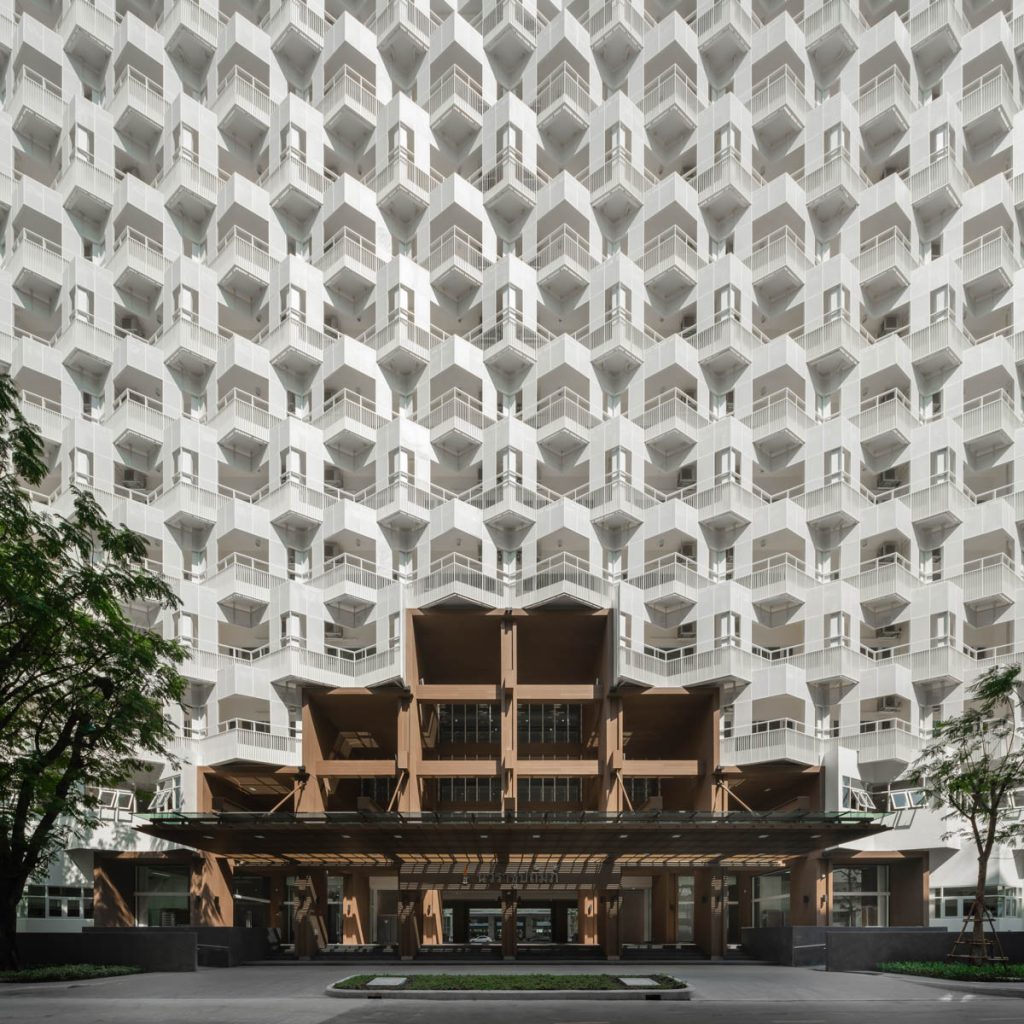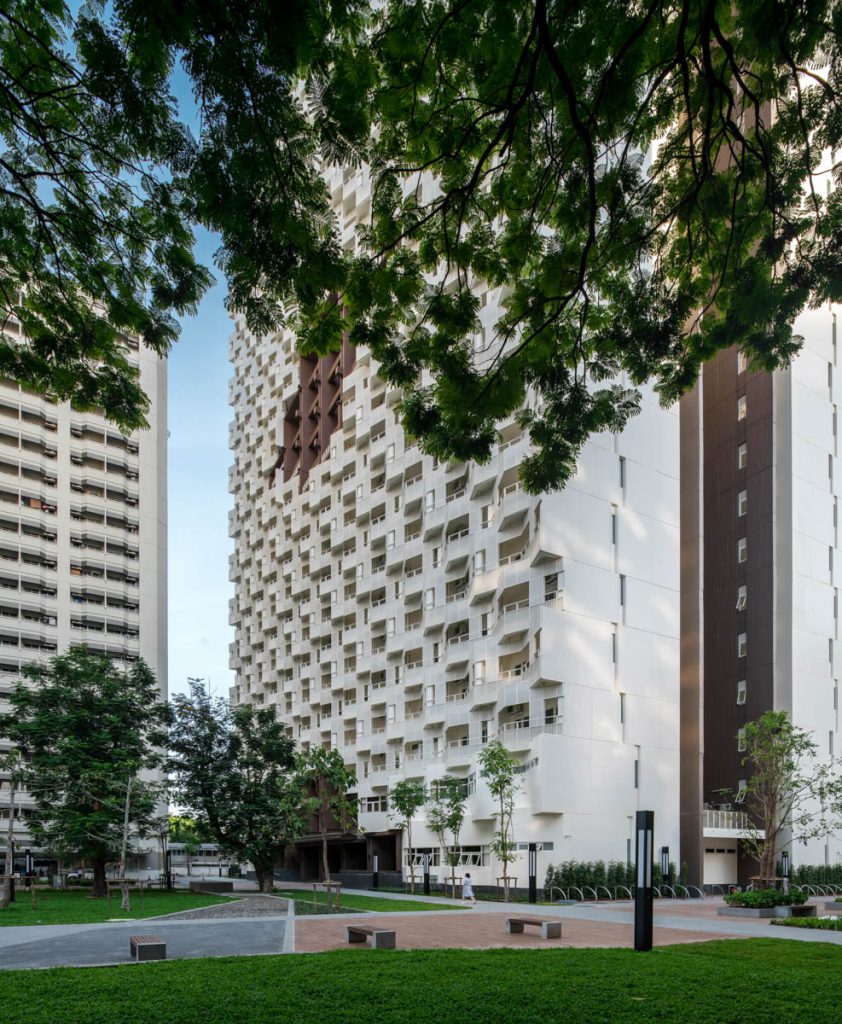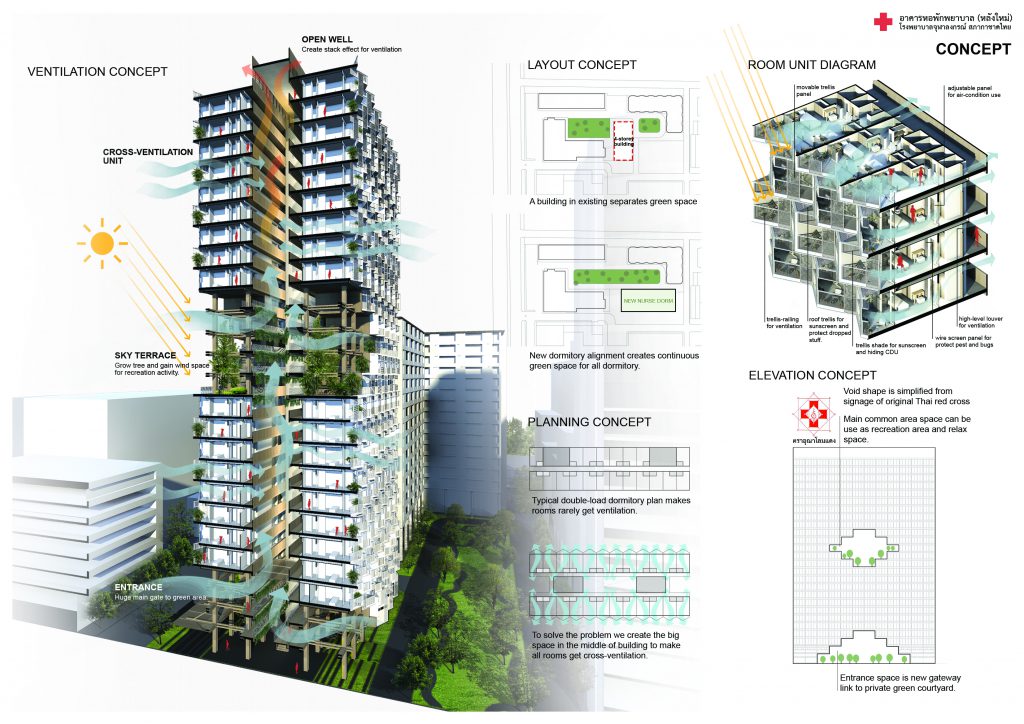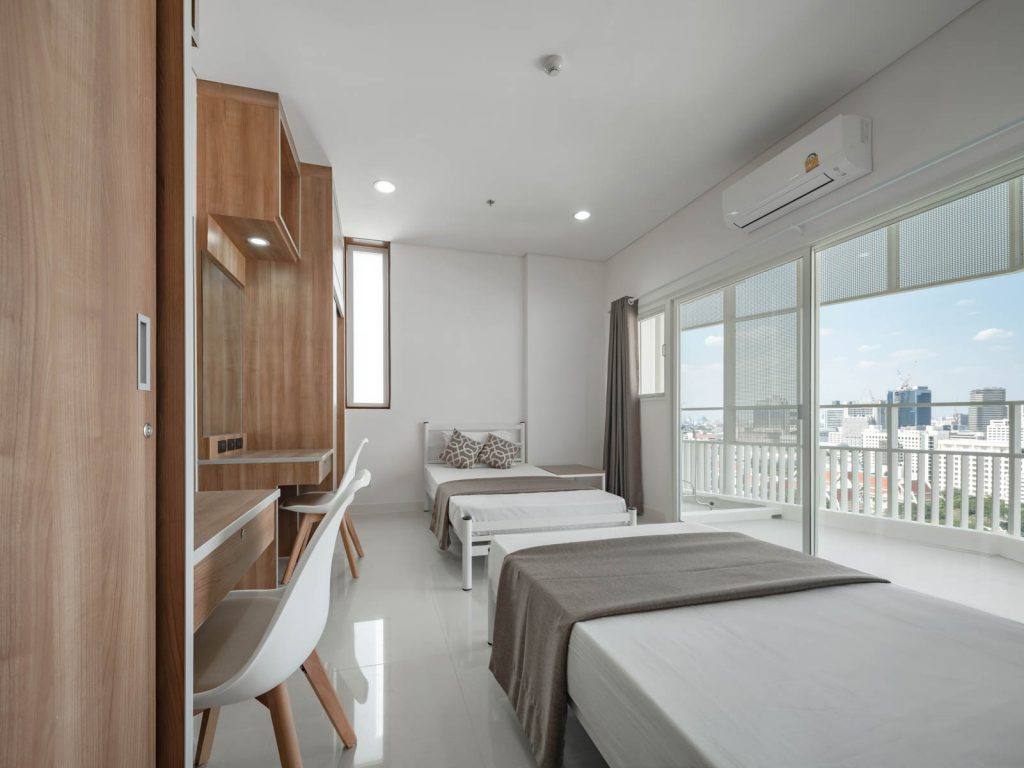Situated in a dense community in Chulalongkorn Memorial Hospital’s area, this new nurse dormitory was designed by Plan Architect with the aim to decrease the usage of air-conditioning and create all physical comforts and promote well-being for its users.
Text: Warut Duangkaewkart
Photo: Panoramic Studio
ไม่บ่อยครั้งนักที่เราจะได้เห็นอาคารในส่วนของราชการที่ถูกออกแบบให้น่าสนใจ ไม่ว่าด้วยงบประมาณหรือรูปแบบที่เป็นข้อบังคับต่างๆ ทำให้อาคารราชการส่วนใหญ่มีลักษณะคล้ายกัน แต่สำหรับโครงการหอพักพยาบาลของโรงพยาบาลจุฬาลงกรณ์หลังนี้ สร้างขึ้นมาใหม่เพื่อตอบสนองการใช้งานที่เฉพาะและตอบโจทย์วิถีชีวิตของพยาบาลที่มีความต้องการเฉพาะเจาะจงออกไปจากรูปแบบหอพักแบบเดิมๆ โดยทาง Plan Architect เป็นผู้ได้รับคัดเลือกให้ออกแบบโครงการนี้
Download the online journal Issue 01 The ComfortZone Click here
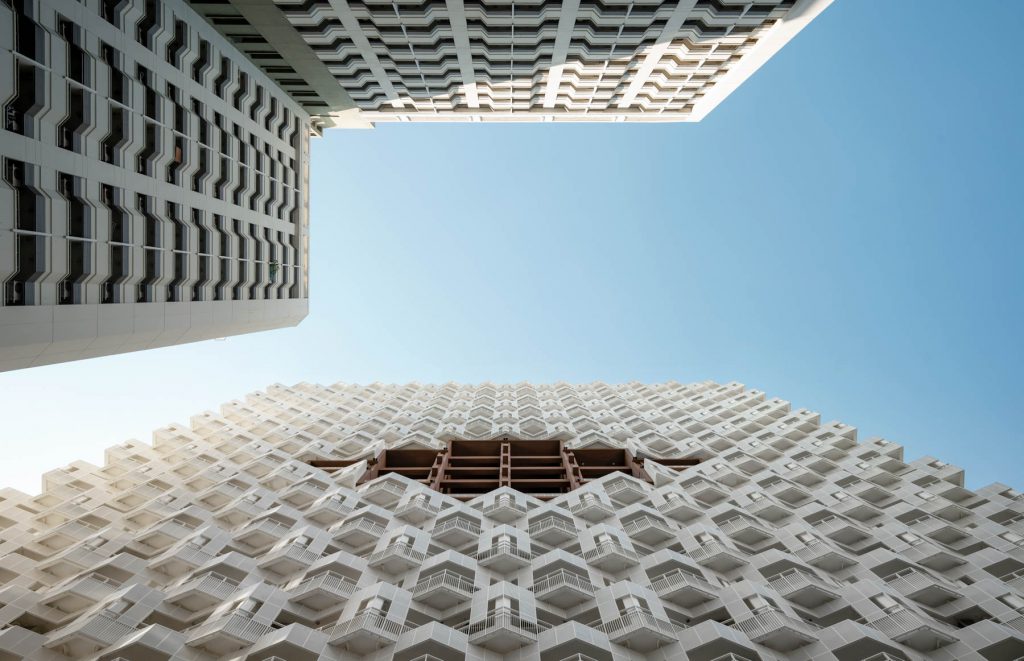
โครงการนี้เป็นงานประกวดแบบที่ทางโรงพยาบาลจุฬาฯ ต้องการสร้างหอพักพยาบาล โดยผู้ออกแบบได้รับโจทย์ทั้งในแง่ของการใช้งาน จำนวนห้องต่างๆ พร้อมกับข้อมูลที่เกี่ยวกับความเป็นอยู่ รูปแบบการอยู่อาศัยที่หนึ่งห้องพักจะอยู่อาศัยกัน 2 คนเป็นคู่ หรือรายละเอียดที่น่าสนใจอย่างผู้อยู่อาศัยมักจะอยู่ในห้องโดยเปิดหน้าต่างกันเป็นส่วนใหญ่ ซึ่งเป็นงานที่เริ่มต้นมาจากข้อมูลของผู้ใช้งานจริงและเพื่อตอบโจทย์ของโครงการที่ต้องการจะสร้างหอพักพยาบาลขึ้นมาใหม่ให้เพียงพอต่อความต้องการจากข้อมูลที่ได้รับ ผู้ออกแบบจึงใช้แนวความคิดหลักในเรื่องของภาวะอยู่สบาย การจัดการลม การถ่ายเทอากาศให้เกิดขึ้นภายในอาคาร และสร้างสภาพแวดล้อมที่เหมาะสมกับโปรแกรมให้มากที่สุด โดยเริ่มจากการศึกษาพื้นที่ รื้อถอนอาคารเดิมออกแบบอาคารใหม่รวมถึงวางผังบริเวณโดยรอบ สร้างให้เกิดพื้นที่สีเขียวควบคู่ไปกับอาคารหอพักโดยมุ่งเน้นให้เกิดความน่าอยู่อาศัยจากภายในเป็นจุดเริ่มต้นของโครงการนี้
Photo: Panoramic Studio Photo: Panoramic Studio
“ตอนที่วาง layout เราอยากให้อาคารเข้ามาทำให้พื้นที่นี้ดูลงตัวมากขึ้น ซึ่งจากอาคารเก่าที่มีอยู่เดิมจะตั้งขวางพื้นที่อยู่เราจึงปรับใหม่โดยเสนอรื้ออถอนอาคารเก่า 4 ชั้น เดิมออกเพื่อเชื่อมพื้นที่สวนด้านหลังให้เกิดเป็นพื้นที่คอร์ทเปิดโล่งขนาดใหญ่ขึ้นมา ซึ่งพื้นที่สีเขียวท่ามกลางตึกหอพักนี้จะทำให้พื้นที่บริเวณนี้ค่อนข้างสงบขึ้นมาเลย เราจึงเสนอ master plan เพื่อสร้างให้เกิดสวนที่ทุกคนสามารถเข้ามาใช้งานได้” แนวความคิดของ Plan Architect ในการสร้างบรรยากาศโดยรวมของพื้นที่ โดยยังได้ออกแบบให้พื้นที่ชั้น 1 บริเวณทางเข้าหลักของอาคารเปิดโล่งเชื่อมระหว่างถนนด้านหน้าและเปิดสู่พื้นที่สวนด้านหลัง
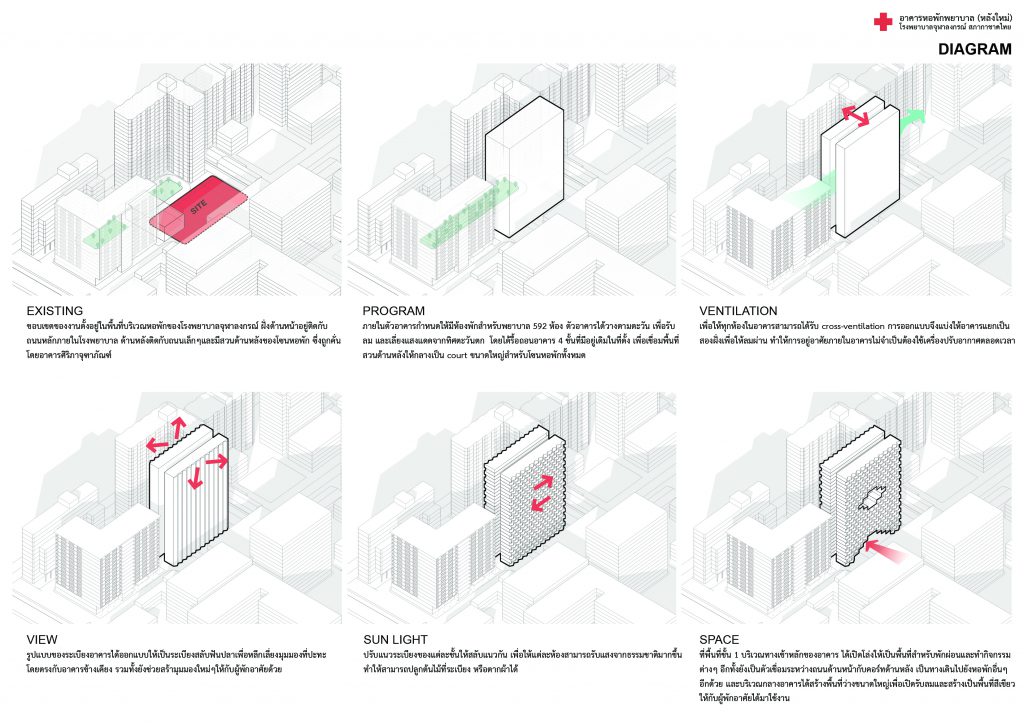
จากขอบเขตของพื้นที่ที่ถูกกำหนดไว้ พื้นที่ก่อสร้างติดกับถนนหลักที่เข้ามาจากถนนอังรีดูนังต์ ตัวอาคารถูกจัดวางตามแนวตะวันเพื่อรับลมและหลีกเลี่ยงแดดจากทิศตะวันตกที่จะส่องเข้าตัวอาคาร โดยพื้นที่ภายในได้ปรับจากรูปแบบการจัดวางหอพักเดิมๆ ที่ไม่สามารถถ่ายเทอากาศภายในได้ ผู้ออกแบบจึงสร้างระยะห่างของทางเดินระหว่างห้องพัก ให้เกิดเป็นพื้นที่สัญจรเปิดโล่งเพื่อให้อากาศถ่ายเทอีกทั้งยังช่วยให้เกิดพื้นที่ขนาดย่อมเพื่อรองรับการใช้งานภายนอกห้องบางส่วนด้วย ซึ่งหากมองจากภาพรวมแล้วความน่าสนใจของโครงการนี้คือการนำลมธรรมชาติเข้าสู่ตัวอาคารและทำให้เกิดการไหลเวียนของอากาศภายในให้ได้มากที่สุด ทั้งช่องเปิดขนาดใหญ่ ที่สามารถมองเห็นได้จากทางเข้าอาคาร และกลางตัวอาคารด้านบนรวมถึงการออกแบบห้องพักที่มีรายละเอียดที่น่าสนใจไม่ต่างกัน
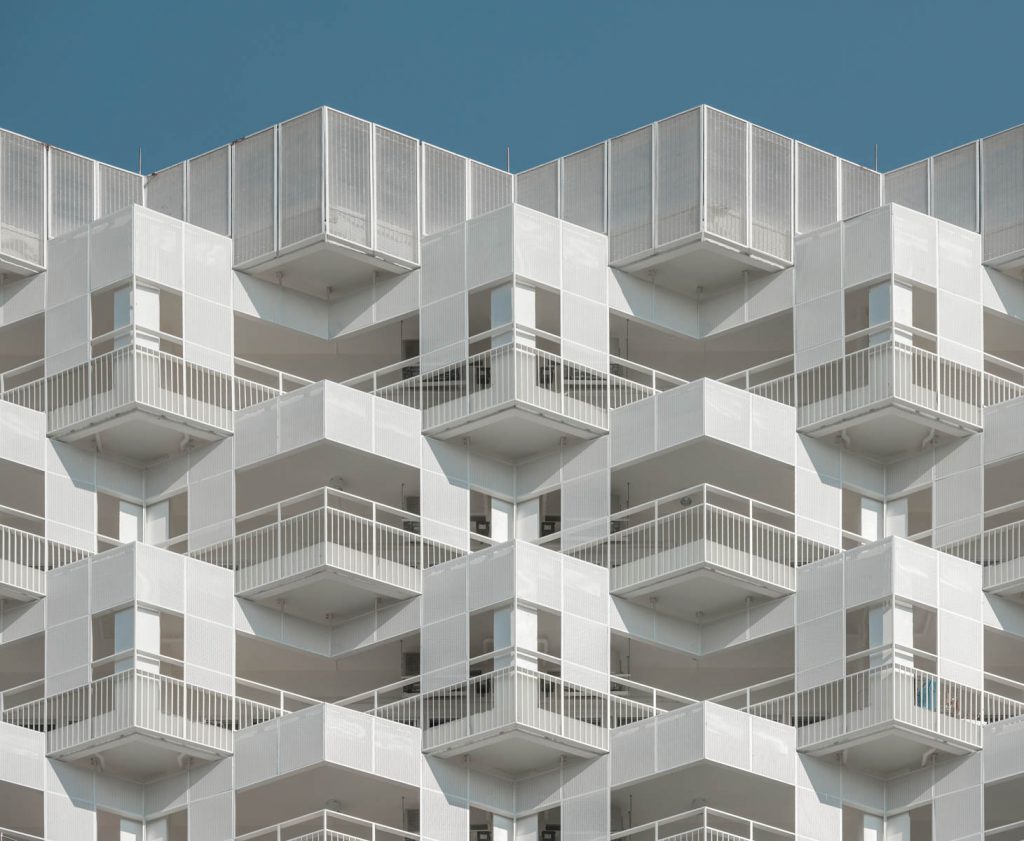
จากข้อมูลทั้งหมดนำไปสู่การเริ่มออกแบบจากพื้นที่ที่เล็กที่สุดคือ “ห้องพัก” เมื่อนำแนวความคิดเรื่องความอยู่สบายเข้ามาร่วมออกแบบจึงทำให้เกิดรายละเอียดที่ตอบโจทย์ในเรื่องนี้ เริ่มจากการระบายอากาศที่เป็นไอเดียหลักในการทำให้ห้องมีความโปร่ง แต่ยังคงรู้สึกปลอดภัยและเป็นส่วนตัวในเวลาเดียวกัน ด้วยพื้นที่ที่เป็นเสมือนประตู 2 ชั้น หากไส่ลำดับจากภายนอกห้องประตูด้านหน้าถูกออกแบบให้เป็นบานประตู 2 ชั้น ทั้งบานทึบและมุ้งลวดเพื่อตอบโจทย์การใช้งานสำหรับผู้ที่ไม่ต้องการเปิดแอร์ ช่วยให้เกิดการถ่ายเทอากาศจากภายในสู่ภายนอก จัดวางพื้นที่สำหรับส่วนเตรียมอาหาร (pantry) และห้องน้ำโดยทำหน้าที่เป็นส่วนต้อนรับสำหรับใช้งานร่วมกัน พื้นที่ส่วนนี้จะถูกคั่นด้วยประตูบานทึบอีกชั้นหนึ่งก่อนที่จะเข้าสู่บริเวณห้องนอนสำหรับความปลอดภัยและการใช้งานเมื่อต้องการเปิดเครื่องปรับอากาศ ทำให้ตอบสนองความต้องการที่หลากหลายของผู้ใช้งานได้
ในส่วนของการใช้งานภายใน จากรูปแบบของหอพักที่เป็นห้องพักรวมแบบเดิม ซึ่งมักจะจัดพื้นที่อย่างโต๊ะทำงาน เตียงนอน ให้อยู่ใกล้กันหรือฝั่งเดียวกันเสมอ ทำให้ความรู้สึกของผู้อยู่นั้นไม่เป็นส่วนตัวเท่าที่ควร ผนวกกับการใช้งานของพยาบาลที่จะอยู่ในที่พักไม่เป็นเวลาเพราะต้องทำงานให้สอดคล้องกับกะที่ตัวเองได้รับ การแบ่งแยกพื้นที่การใช้งานออกเป็น 2 ฝั่ง จึงช่วยให้เกิดความเป็นส่วนตัวมากขึ้น ด้วยความกว้าง 5 เมตร การแบ่งพื้นที่ใช้งาน 2 ฝั่งจึงมีขนาดที่เพียงพอช่วยลดปัญหาเรื่องเสียงรบกวน หรือช่วงเวลาการใช้พื้นที่ที่แตกต่างกัน และยังเหลือพื้นที่เป็นทางเดินเผื่อไปยังระเบียงได้
Photo: Panoramic Studio Photo: Panoramic Studio
หากจะพูดถึงหอพักแล้ว เป็นปัญหาสำคัญอีกมุมหนึ่งคือการสร้างความเป็นส่วนตัวให้เกิดขึ้นจากภายนอก ด้วยความที่พื้นที่โดยรอบเป็นหอพักเหมือนกัน การใช้งานพื้นที่ระเบียงนั้นผู้ออกแบบตั้งใจสร้างเปลือกอาคารขึ้นมาจากแผงอลูมีเนียมเจาะรู เพื่อให้เกิดเป็นฉากกั้นระหว่างภายใ นและภายนอก ปิดส่วนที่เป็นงานระบบอย่าง CDU ของเครื่องปรับอากาศ แต่ยังคงสามารถรับแสงธรรมชาติ และถ่ายเทอากาศได้อยู่ พร้อมกับปรับมุมมองด้วยการแกนเล็กน้อยที่ระเบียง จัดวางแบบสลับรูปแบบในแต่ละชั้น เพื่อให้มีองศาของมุมมองต่างออกไปจากอาคารโดยรอบ ช่วยให้เกิดพฤติกรรมการใช้งานที่รู้สึกปลอดภัยมากขึ้น นอกจากนี้ยังตอบโจทย์เรื่องฟังก์ชั่นการใช้งาน โดยระเบียงของห้องพักแต่ละห้องนั้นจะรองรับการใช้งานทั้งการวางเครื่องซักผ้า ตากผ้ารวมถึงการปลูกต้นไม้ ที่เป็นกิจกรรมที่ได้ข้อมูลมาจากการพูดคุยกับผู้ใช้งานจริง
จากภายนอกจึงสามารถมองเห็นลวดลายและพื้นผิวของ Façade ที่เรียงตัวสลับกันไปอย่างโดดเด่น และช่องเปิดขนาดใหญ่ที่ได้รับแรงบันดาลใจมาจากตราอุณาโลมแดง ซึ่งเป็นสัญลักษณ์เก่าของสภากาชาดไทย โดยผู้ออกแบบได้ลดทอนสัดส่วน และนำมาใช้เพื่อให้เกิดช่องเปิดสำหรับถ่ายเทอากาศขนาดใหญ่ ที่ด้านล่างที่ซึ่งเป็นโถงทางเข้าของอาคารและด้านบนที่เป็นเสมือนหน้าต่างบานใหญ่ช่วยให้ลมถ่ายเทเข้าไปสู่พื้นที่ภายใน จากด้านล่างสู่ด้านบน อีกทั้งยังเกิดเป็นพื้นที่ส่วนรวม (common area) ย่อยๆ เพื่อให้เกิดการใช้งานให้พื้นที่ส่วนกลางสร้างปฏิสัมพันธ์กันระหว่างผู้อยู่ในอาคารได้อีกด้วย
จากรายละเอียดในงานออกแบบอาคารหอพักพยาบาลจำนวน 523 ห้อง นี้ จะเห็นว่าในทุกการออกแบบสามารถที่จะประยุกต์เพื่อปรับเปลี่ยน หรือปรับตัวให้เข้ากับการใช้งานที่แตกต่างกันออกไป ซึ่งไม่ใช่เพียงเรื่องรูปลักษณ์ภายนอก แต่เป็นการออกแบบจากจุดที่เล็กที่สุดเพื่อเสริมให้เกิดประสิทธิภาพสูงสุดในการใช้พื้นที่ใดพื้นที่หนึ่ง โครงการหอพักพยาบาลโรงพยาบาลจุฬาลงกรณ์นี้ เป็นอีกโครงการหนึ่งที่ทำให้เห็นถึงการออกแบบที่เริ่มมาจากพฤติกรรมของผู้ใช้งาน มุ่งเน้นในการออกแบบให้เกิดภาวะอยู่สบายตอบสนองการใช้งานและช่วยยกระดับคุณภาพชีวิตของผู้อยู่อาศัยได้ซึ่ง เป็นสิ่งสำคัญที่จะต้องคำนึงถึงเสมอในการออกแบบงานสถาปัตยกรรม
Photo: Plan Architect
It’s not a common occurrence to see a government building with a visually exciting design in Thailand. Whether it’s the budget or rules and regulations that causes most of these buildings to look painfully similar, that is not the case of the Nurse Dormitory Chulalongkorn Memorial Hospital.
The project was initiated to accommodate the specific functionalities and the nurses’ unique lifestyle. Plan Architect, the firm chosen to oversee the creation of the project, develops the design that follows a set of requirements, aesthetically and functionally which sets the project apart from most dormitory buildings.
Chulalongkorn Hospital hosted the design competition for the project, in which the selected team would be given the brief that provided several functional requirements. The information ranged from simple data such as the number of rooms, information regarding the general well-being of the building’s residents, to the room type and layout, which would have to accommodate two people per room. Another interesting detail included in the briefs is that most residents tend to leave the windows open when they’re in a room. The data was collected from actual building users and provided for the design team to create a new facility that would comprehensively answer all these requirements. After reviewing and studying the information, the design concept was developed. It highlighted the importance of thermal comfort, manipulation and management of cross-ventilation, and physical environment, all executed to best comply with the building’s functional program. The process began with site analysis, followed by the demolition of the old structure and the design development of the new site plan, which included the green space and the dormitory building. The design team considered the quality of interior spaces as the main focus, for it serves as the key to the project’s liveability and users’ well-being.
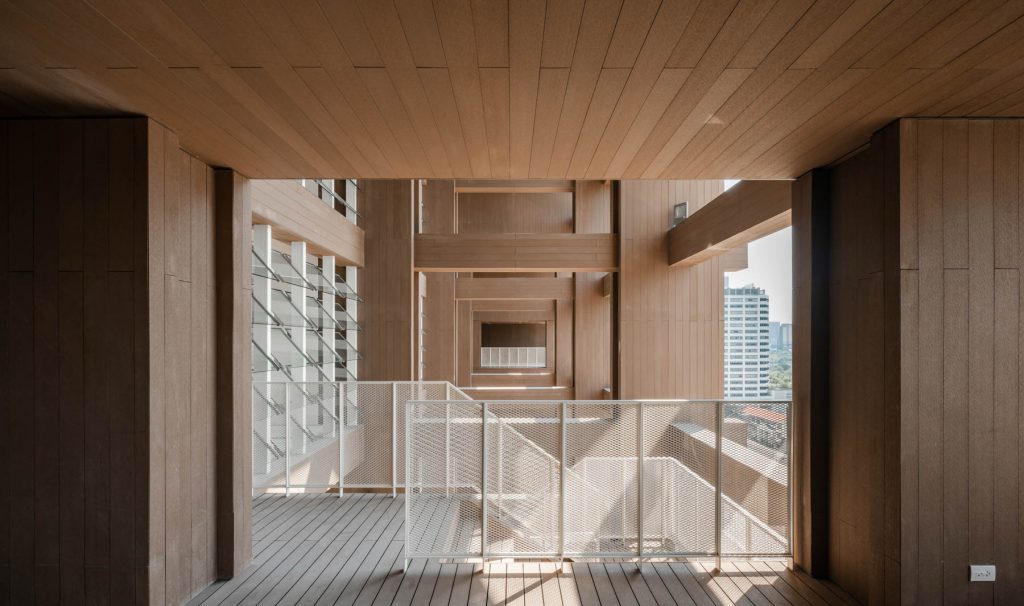
“When we were working on the layout, we wanted the building to be a complementing addition to the site. With the old building in the way, we readjusted the site by demolishing the four-story structure to connect the garden at the back into a large, open courtyard. The green space in the middle of the dormitory building would bring a sense of serenity to the area. That is why the master plan we proposed included a garden where everyone feels welcome to use.”
Opening up the first-floor area’s main entrance and linking both the front street and space at the back into one spatial flow follows the design concept that Plan Architect came up with to set the overall mood of the program. The defined periphery situates the new building next to the main street, accessed through Henri Dunant Road. The orientation of the site is facing north which opens the functional spaces to natural wind while avoiding the afternoon daylight. The interiors see an interesting adjustment of space allocation and layout. Unlike most dormitory buildings with ineffective ventilation, the design creates an open, single-loaded corridor to enable airflow and ventilation, simultaneously forming a series of small outdoor spaces for some living units. The design is distinctive for the way it incorporates natural wind to optimize natural interior ventilation. Large openings are visible from the main entrance and the upper part of the structure. Not only that, the design of the living units itself contains equally intriguing details.
The data led to the design of the small unit, the “rooms.” The integration of thermal comfort gave birth to several details, which allows the design to achieve the intended result. Ventilation, as the critical method that can keep the rooms airy, comes hand in hand with a user’s sense of safety and privacy. The space in each unit is designed to have two layers of entrances. The front door with direct access to the outside consists of a door and an insect screen, offering alternatives for users who don’t like to turn on air conditioners while enabling airflow to run through the interior to the exterior space. The pantry and restroom situated towards the front is a part of the shared living space, which is partitioned by another door that leads to the sleeping area. This layout provides users with a sense of safety and privacy while localizing air conditioner use in the bedroom, ultimately accommodating the diverse demands of the roommates who share the room.
The design takes a different approach when it comes to the room layout. Most of the time, a shared dormitory unit tends to place the desk near the bed, toward the same side of the room, which tends to lessen privacy for users. With this project, the users are nurses who work in shifts with unconventional working and resting hours. To make each user feel like they have a greater sense of privacy, the design team divides the interior functional space into two sides. Thanks to each unit being five-meters wide, there’s sufficient room to share between two roommates while disturbing noises and activities caused by each user’s different work schedules are effectively minimized. The layout also leaves a spare space for a small walkway leading to the balcony.

Another important and somewhat challenging aspect of dormitory buildings is protecting the residents’ privacy from outside access. With the project is neighboring several other dormitory buildings, the balcony included in each unit is partitioned with a specifically designed facade made of perforated aluminum panels. Not only can the enveloping mass help separate the interiors from the exteriors while shielding the unpleasant sight of the air conditioning system’s CDU, but the perforated aluminum panels also welcomes natural light and enables ventilation at the same time. Installed in a slightly deviated angle from the balcony with an alternating format for each floor, the facade physically and visually diverges from the surrounding buildings. The divergence introduces a greater sense of privacy to the living units while still allowing the balcony to fulfill its functional requirements as the laundry area and where residents can grow a small garden (the information about these activities is collected from a group of actual users).
From the outside, one can see the textural details of the facade appearing in a distinctive alternating arrangement, accompanied by a series of large vents. The pattern takes inspiration from the old Thai red cross sign called ‘Una Loam Daeng’ symbol with simplified details and proportions, creating a sizable opening at the building’s main entrance and what looks like a large window on the upper part of the building. Collectively, these openings help maximize the efficiency of natural ventilation by allowing natural airflow to travel from the ground level and through the interior space. This functionally-driven layout also ends up creating a mid-sized common area that encourages interactions between the residents.
Photo: Panoramic Studio Photo: Panoramic Studio Photo: Panoramic Studio
All the details of this 523-room nurse dormitory reveal how design extends beyond physical appearance as it adapts to cater to different functionalities. It is developed from the smallest unit and gradually optimizes the efficiency of the entire spatial usage. Nurse Dormitory Chulalongkorn Memorial Hospital exemplifies user-oriented design, which gives birth to a building of maximized thermal comfort, equipped with all the needed functionalities that can genuinely improve users’ quality of life. It has all the qualities an excellent work of architecture is expected to have.




